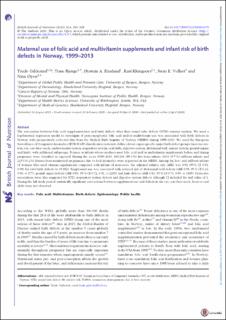| dc.description.abstract | The association between folic acid supplementation and birth defects other than neural tube defects (NTD) remains unclear. We used a log-binomial regression model to investigate if periconceptional folic acid and/or multivitamin use was associated with birth defects in Norway with prospectively collected data from the Medical Birth Registry of Norway (MBRN) during 1999–2013. We used the European Surveillance of Congenital Anomalies (EUROCAT) classification system to define eleven organ-specific major birth defect groups (nervous system, eye, ear–face–neck, cardiovascular system, respiratory system, oral clefts, digestive system, abdominal wall, urinary system, genital organs and limb), with additional subgroups. Fetuses or infants whose mothers used folic acid and/or multivitamin supplements before and during pregnancy were classified as exposed. During the years 1999–2013, 888 294 (99·0 %) live-born infants, 6633 (0·7 %) stillborn infants and 2135 (0·2 %) fetuses from terminated pregnancies due to fetal anomalies were registered in the MBRN. Among the live- and stillborn infants of women who used vitamin supplements compared with infants of non-users, the adjusted relative risk (aRR) was 0·94 (95 % CI 0·91, 0·98) for total birth defects (n 18 382). Supplement use was associated with reduced risk of abdominal wall defects (aRR 0·58; 95 % CI 0·42, 0·80, n 377), genital organ defects (aRR 0·81; 95 % CI 0·72, 0·91, n 2299) and limb defects (aRR 0·81; 95 % CI 0·74, 0·90, n 3409). Protective associations were also suggested for NTD, respiratory system defects and digestive system defects although CI included the null value of 1. During the full study period, statistically significant associations between supplement use and defects in the eye, ear–face–neck, heart or oral clefts were not observed. | en_US |

